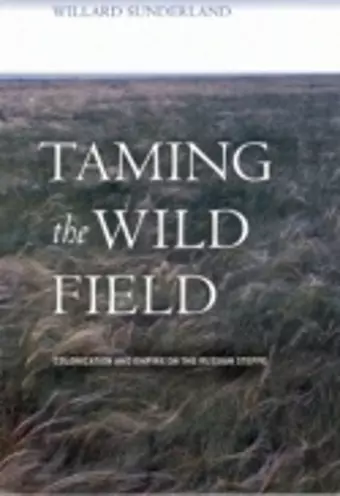Taming the Wild Field
Colonization and Empire on the Russian Steppe
Format:Hardback
Publisher:Cornell University Press
Published:20th May '04
Currently unavailable, and unfortunately no date known when it will be back
This hardback is available in another edition too:
- Paperback£19.99(9780801473470)

Stretching from the tributaries of the Danube to the Urals and from the Russian forests to the Black and Caspian seas, the vast European steppe has for centuries played very different roles in the Russian imagination. To the Grand Princes of Kiev and Muscovy, it was the "wild field," a region inhabited by nomadic Turko-Mongolic peoples who repeatedly threatened the fragile Slavic settlements to the north. For the emperors and empresses of imperial Russia, it was a land of boundless economic promise and a marker of national cultural prowess. By the mid-nineteenth century the steppe, once so alien and threatening, had emerged as an essential, if complicated, symbol of Russia itself.Traversing a thousand years of the region's history, Willard Sunderland recounts the complex process of Russian expansion and colonization, stressing the way outsider settlement at once created the steppe as a region of empire and was itself constantly changing. The story is populated by a colorful array of administrators, Cossack adventurers, Orthodox missionaries, geographers, foreign entrepreneurs, peasants, and (by the late nineteenth century) tourists and conservationists. Sunderland's approach to history is comparative throughout, and his comparisons of the steppe with the North American case are especially telling.Taming the Wild Field eloquently expresses concern with the fate of the world's great grasslands, and the book ends at the beginning of the twentieth century with the initiation of a conservation movement in Russia by those appalled at the high environmental cost of expansion.
As Willard Sunderland points out in this pioneering study of the colonization of the Russian steppe, the 'wild field' in his title, historians have been largely as prone as Russian rulers to accept the vision of the eighteenth-century cartographers that the steppes were an empty space awaiting to be peopled.... Sunderland offers a fresh perspective from which to appreciate history's multiple experiences with decolonization.
* Journal of World History *In this sweeping survey, Sunderland details processes of Russia's colonization of the steppe that highlight its particularities as well as place the country within a larger western imperial pattern of expansion.... He thoughtfully considers the complexity of steppe expansion, and what it tells us about educated society, the state, and empire in Russia, as well as fitting this expansion into a global pattern from the sixteenth to the end of the nineteenth century.
* Journal of Colonialism and Colonial History *The 'wild field' was the name given by the early forest-dwelling Eastern Slavs to the immense grasslands (also known as the steppe) that stretched north of the Black Sea from the Danube River to the Ural Mountains.... In this excellent book, Sunderland examines the expansion of Russia into this area.... Using extensive local and national archives, the author shows that this colonization changed over time and established a multifaceted imperialism that involved empire building, state building, society building, and nation building. Sunderland makes frequent comparisons to the history of similar regions such as the North American Great Plains. Highly recommended.
* Choice *This book provides an engaging and provocative account of the role of popular and state initiatives in Russian colonization of the Black Sea-Caspian steppe from the sixteenth century to the late nineteenth century.... Taming the Wild Field makes the case for reasserting the importance of late Muscovite and Imperial Russian history by placing them within the larger contexts of the history of Inner Eurasia and the comparative study of empire.
* Russian ReviISBN: 9780801442094
Dimensions: 235mm x 155mm x 22mm
Weight: 907g
264 pages